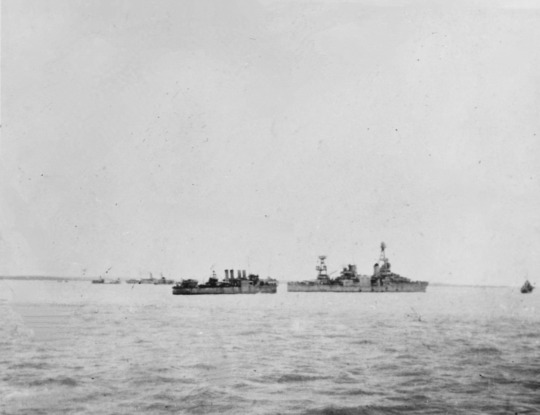#USS Peary (DD-226)
Text

USS HOUSTON (CA-30) and USS PEARY (DD-226) at Darwin, Northern Territories, Australia, in February 1942. "Houston departed Darwin on February 15, 1942 with a small convoy to reinforce the garrison on Timor and was not present when Japanese aircraft raided Darwin four days later."
Australian War Memorial: P05303.011
#USS Houston (CA-30)#USS Houston#Northampton Class#Cruiser#USS Peary (DD-226)#USS Peary#Clemson Class#Destroyer#warship#ship#February#1942#World War II#World War 2#WWII#WW2#WWII History#History#Darwin#Northern Territories#Australia#united states navy#us navy#navy#usn#u.s. navy#my post
63 notes
·
View notes
Photo

“Looking from the Australian Corvette, HMAS Warrnambool (J 202), towards the USS Houston (CA-30) (right), with the USS Peary (DD-226) along side in early February, 1942.
Australian War Memorial, Photo #P05303.011.″
(Source)
#Military#History#USS Houston#Heavy cruiser#USS Peary#Destroyer#United States Navy#US Navy#WWII#WW2#Pacific War#World War II
54 notes
·
View notes
Quote
All thirteen of the flushdeckers that would later make up Destroyer Squadron 29 of the U.S. Asiatic Fleet, from USS Alden (DD-211) to USS Paul Jones (DD-230), were constructed by William Cramp & Sons of Philadelphia. Authorized by the First Session of the 65th Congress in 1917 as “Torpedo-boat destroyers,” they, too, were built rapidly, often in less than a year. But Cramp ships were strongly framed, even if not designed with enough ventilation for service in the torrid East Asian climate.
And for those who may put stock in the portents of numerology in preference to the workmanship, the welded plates, rivets, and bolts of Cramp & Sons DDs 224, 225, and 226 (Stewart, Pope, and Peary) were all laid down on the same day: the ninth day of the ninth month of 1919.
All three were lost in the Java campaign as members of the ill-fated Destroyer Squadron 29. Their hull numbers at Cramp & Sons were respectively 490, 491, and 492.
A fourth destroyer of that heroic, unlucky baker’s dozen, hull number 485, was laid down six days after the previously mentioned three, on September 15, 1919, and she would be launched on July 29, 1920.
A Blue Sea of Blood: Deciphering the Mysterious Fate of the USS Edsall, by Donald M. Kehn
14 notes
·
View notes
Photo

A colorized photograph of USS Black Hawk (AD-9) with USS Pillsbury (DD-227), USS Pope (DD-225), USS Ford (DD-228), USS Paul Jones (DD-230), USS Peary (DD-226) and USS Parrott (DD-218) alongside in Chefoo, China.
#US Navy#Interwar period#flushdeck destroyer#destroyer#warship#USN#destroyer tender#USS Black Hawk (AD9)#USS Pillsbury (DD227)#USS Pope (DD225)#USS Ford (DD228)#USS Paul Jones (DD230)#USS Peary (DD226)#USS Parrott (DD218)
48 notes
·
View notes
Text

"USS HOUSTON (CA-30) (right center) at Darwin, Australia, probably on February 15 or 18, 1942. The destroyer astern of HOUSTON may be USS PEARY (DD-226). Among the ships in the background, to the left, are HMAS TERKA and the SS Zealandia. The donor was on board HMAS TOLGA, then used as a water carrier for ships in Darwin harbor."
Courtesy of Arthur W. Thomas.
U.S. Naval History and Heritage Command: NH 43649
#USS Houston (CA-30)#USS Houston#Northampton Class#Cruiser#warship#ship#February#1942#USS Peary (DD-226)#USS Peary#Clemson Class#Destroyer#world war 2#world war ii#WW2#WWII#WWII History#History#Darwin#Australia#united states navy#us navy#navy#usn#u.s. navy#my post
38 notes
·
View notes
Photo

Taken June 1933 from the breakwater in Chifoo of the USS Black Hawk (AD-9) with the USS Bulmer (DD-222), USS Pillsbury (DD-227), USS Pope (DD-225), USS Ford (DD-228), USS Edsall (DD-219) and USS Peary (DD-226) alongside.
#US Navy#Interwar period#flushdeck destroyer#destroyer#warship#USN#destroyer tender#USS Black Hawk (AD9)#USS Bulmer (DD222)#USS Pillsbury (DD227)#USS Pope (DD225)#USS Ford (DD228)#USS Edsall (DD219)#USS Peary (DD226)
36 notes
·
View notes
Photo

Starboard quarter view of the U.S. Navy tanker USS Victoria (AO-46) (ex George G. Henry) with four old four stack destroyers alongside. This photo could have been taken at Fremantle, Australia, when the tanker - still George G. Henry - fueled the four surviving American ships that took part in the Battle of the Java Sea, the destroyers USS Alden (DD-211), USS John D. Edwards (DD-216), USS John D. Ford (DD-228), and USS Paul Jones (DD-230), soon after they arrived in Australian waters.
On 15 April 1942, while at Yarraville, a suburb of Melbourne, George G. Henry was taken over by the U.S. Navy under a bareboat charter and commissioned as USS Victoria (AO-46). Survivors from the sunken USS Langley (AV-3), USS Peary (DD-226), and USS Pecos (AO-6) made up the ship's new crew.
#US Navy#flushdeck destroyer#destroyer#warship#USN#oiler#USS Victoria (AO46)#USS Alden (DD211)#USS John D. Edwards (DD216)#USS John D. Ford (DD228)#USS Paul Jones (DD230)#WWII#WW2#world war two
7 notes
·
View notes